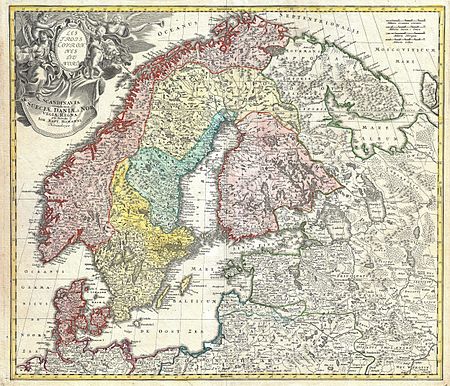 Global Information
Global InformationHistory of Norway information

| History of Norway |
|---|
 |
| Timeline |
|
|
| Part of a series on |
| Scandinavia |
|---|
 |
|
The history of Norway has been influenced to an extraordinary degree by the terrain and the climate of the region. About 10,000 BC, following the retreat inland of the great ice sheets, the earliest inhabitants migrated north into the territory which is now Norway. They traveled steadily northwards along the coastal areas, warmed by the Gulf Stream. They were hunter-gatherers whose diet included seafood and game, particularly reindeer as staple foods. Between 5,000 BC and 4,000 BC the earliest agricultural settlements appeared around the Oslofjord. Gradually, between 1,500 BC and 500 BC, agricultural settlements spread to the entire south Norway, while the inhabitants of the regions north of Trøndelag continued to hunt and fish.
The Neolithic period started in 4,000 BC. The Migration Period caused the first chieftains to take control and hilltop forts to be constructed. From the 8th century Norwegians started expanding across the seas to the British Isles and later Iceland and Greenland. The Viking Age also saw the unification of the country. Christianization was completed during the 11th century and Nidaros became an archdiocese. The population expanded quickly until 1349 (Oslo: 3,000; Bergen: 7,000; Trondheim: 4,000)[citation needed] when it was halved by the Black Death and successive plagues. Bergen became the main trading port, controlled by the Hanseatic League. Norway entered the Kalmar Union with Denmark and Sweden in 1397.
After Sweden left the union in 1523, Norway became the junior partner in Denmark–Norway. The Reformation was introduced in 1537 and absolute monarchy imposed in 1661. In 1814, after being on the losing side of the Napoleonic Wars with Denmark, Norway was ceded to the king of Sweden by the Treaty of Kiel. Norway declared its independence and adopted a constitution. However, no foreign powers recognized the Norwegian independence but supported the Swedish demand for Norway to comply with the treaty of Kiel. After a short war with Sweden, the countries concluded the Convention of Moss, in which Norway accepted a personal union with Sweden, keeping its Constitution, Storting and separate institutions, except for the foreign service. The union was formally established after the extraordinary Storting adopted the necessary amendments to the Constitution and elected Charles XIII of Sweden as king of Norway on 4 November 1814.
Industrialization started in the 1840s, and from the 1860s large-scale emigration to North America took place. In 1884 the king appointed Johan Sverdrup as prime minister, thus establishing parliamentarism. The union with Sweden was dissolved in 1905. From the 1880s to the 1920s, Norwegians such as Fridtjof Nansen and Roald Amundsen carried out important polar expeditions. Shipping and hydroelectricity were important sources of income for the country. The following decades saw a fluctuating economy and the rise of the labor movement. Germany occupied Norway between 1940 and 1945 during the Second World War, after which Norway joined NATO and underwent a period of reconstruction under public planning. Oil was discovered in 1969 and by 1995 Norway was the world's second-largest exporter. This resulted in a large increase of wealth. From the 1980s Norway started deregulation in many sectors, and in 1989–1990 experienced a banking crisis.
By the 21st century, Norway became one of the world's most prosperous countries with oil and gas production accounting for 20 percent of its economy.[1] By reinvesting its oil revenues, Norway had the world's largest sovereign wealth fund in 2017.[2]
- ^ "Norway Economy: Population, GDP, Inflation, Business, Trade, FDI, Corruption". www.heritage.org. Archived from the original on 25 June 2018. Retrieved 25 June 2018.
- ^ "Lessons from Norway, the world's most inclusive economy". World Economic Forum. 12 April 2017. Archived from the original on 25 June 2018. Retrieved 25 June 2018.